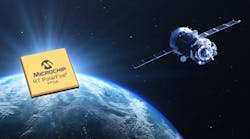NASA selects Microchip Technology to develop spaceflight processor
WASHINGTON - The National Aeronautics and Space Administration's (NASA) Jet Propulsion Laboratory in La Cañada Flintridge, Calif., has selected Microchip Technology Inc. of Chandler, Arizona, to develop a High-Performance Spaceflight Computing (HPSC) processor. Microchip's HPSC will provide at least 100 times the computational capacity of current spaceflight computers. This capability aims to advance all types of future space missions, including surface missions.
Microchip will architect, design, and deliver the HPSC processor over three years, with the goal of employing the processor on future lunar and planetary exploration missions. Microchip's processor architecture will improve the overall computing efficiency for these missions by enabling computing power to be scalable, based on mission needs. The work will take place under a $50 million firm-fixed-price contract, with Microchip contributing significant research and development costs to complete the project.
"We are pleased that NASA selected Microchip as its partner to develop the next-generation space-qualified compute processor platform." said Babak Samimi, corporate vice president for Microchip's Communications business unit. "We are making a joint investment with NASA on a new trusted and transformative compute platform. It will deliver comprehensive Ethernet networking, advanced artificial intelligence/machine learning processing and connectivity support while offering unprecedented performance gain, fault-tolerance, and security architecture at low power consumption. We will foster an industry wide ecosystem of single board computer partners anchored on the HPSC processor and Microchip's complementary space-qualified total system solutions to benefit a new generation of mission-critical edge compute designs optimized for size, weight, and power."
Current space-qualified computing technology is designed to address the most computationally-intensive part of a mission – a practice that leads to overdesigning and inefficient use of computing power. For example, a Mars surface mission demands high-speed data movement and intense calculation during the planetary landing sequence. However, routine mobility and science operations require fewer calculations and tasks per second. Microchip's new processor architecture offers the flexibility for the processing power to ebb and flow depending on current operational requirements. Certain processing functions can also be turned off when not in use, reducing power consumption. This capability will save a large amount of energy and improve overall computing efficiency for space missions.
"Our current spaceflight computers were developed almost 30 years ago," said Wesley Powell, NASA's principal technologist for advanced avionics. "While they have served past missions well, future NASA missions demand significantly increased onboard computing capabilities and reliability. The new computing processor will provide the advances required in performance, fault tolerance, and flexibility to meet these future mission needs."
Microchip's HPSC processor may be useful to other government agencies and applicable to other types of future space mission to explore our solar system and beyond, from Earth science operations to Mars exploration and human lunar missions. The processor could potentially be used for commercial systems on Earth that require similar mission critical edge computing needs as space missions and are able to safely continue operations if one component of the system fails. These potential applications include industrial automation, edge computing, time-sensitive ethernet data transmission, artificial intelligence, and even Internet of Things gateways, which bridge various communication technologies.
